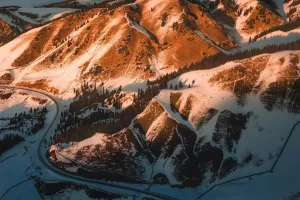If you've ever seen the Rocky Mountains, you can't help but be taken aback by their beauty. When their tops are capped with snow, they make a picture that's breathtaking.
Thinking about the beauty of the mountains got us to thinking about why some of them have snow at the top (called a snowcap) and others don't. Since the top of a mountain is closer to the Sun, shouldn't it be warmer up there? And doesn't heat rise? So why is there snow?
The top of the mountain is actually its coldest spot. As you climb a mountain to a higher altitude (height), the atmosphere gets thinner and thinner. This is because air pressure decreases with altitude.
Even though warm air rises, as it does so the rising air expands and cools. When it expands and cools, it can't absorb and retain heat the way it does at the bottom of the mountain.
Although mountaintops are closer to the Sun, they're also farther away from the thermal heat of the Earth's core that keeps the ground warm. So the top of the mountain can be much colder than the bottom.
In fact, the bottom of a mountain can be located in a tropical jungle while the top of the mountain has snow on it! That's why it's possible to have snow at the equator.
Cooler temperatures at the top of a mountain also mean that there's less evaporation taking place. This leads to greater amounts of moisture in the air. More moisture means more rain and, at the very top of a mountain, more snow.
Not all mountains have snowcaps, and not all mountains that get snow have snowcaps all year. A lot depends upon their location and how tall they are. Mountains lower in altitude are less likely to have snowcaps or to have them all year long.
Many mountains, though, have snowcaps year-round. Above a certain point — called the snow line — it stays cold enough that the snow never melts.
The height of the snow line varies around the globe. It depends upon both altitude (height of the mountain) and latitude (where the mountain is located). The snow line is much higher near the equator (about 15,000 feet), for example, than it is near the poles (sea level or 0 feet in altitude).
The snow line can be affected by other factors, too. For example, in the Andes Mountains of South America, it is so dry that the mountains rarely see snow, despite their height and distance from the equator. Monte Pissis in Argentina is the tallest mountain in the world without a permanent snowcap.
Mountains that are near coastlines may have a lower snow line than other areas with the same altitude and latitude. As you get closer to a coastline, the amount of moisture in the air tends to produce more snowfall at higher altitudes.
Try It Out
Are you ready to climb to new heights of knowledge? Be sure to explore the following activities with a friend or family member:
Ready to cook up a delicious treat? Since we've been learning about how heat rises but mountaintops still can have snow and ice, we thought it might be fun to head to the kitchen to whip up a treat that's both hot and cold. What could it be? Have you ever baked ice cream? No? Well, it's about time you started. Just follow the directions online to learn how to make Baked Ice Cream!
Do you have any snow where you are right now? If not, no worries. You can make your own? Really? You bet! And you'll only need a couple of ingredients. Jump online to learn How To Make Perfect Fake Snow!If you do have snow where you live right now, then what are you waiting for? Get out in the snow and play! If you need help thinking of activities, jump online to check out 20 Fun Activities To Do in the Snow. Choose two or three activities to try with friends and family members.


